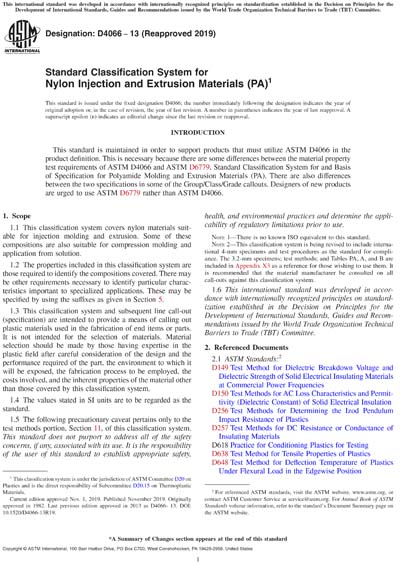Most recent
ASTM D4066-13(2019)
Standard Classification System for Nylon Injection and Extrusion Materials (PA)
1.1 This classification system covers nylon materials suitable for injection molding and extrusion. Some of these compositions are also suitable for compression molding and application from solution.
1.2 The properties included in this classification system are those required to identify the compositions covered. There may be other requirements necessary to identify particular characteristics important to specialized applications. These may be specified by using the suffixes as given in Section 5.
1.3 This classification system and subsequent line call-out (specification) are intended to provide a means of calling out plastic materials used in the fabrication of end items or parts. It is not intended for the selection of materials. Material selection should be made by those having expertise in the plastic field after careful consideration of the design and the performance required of the part, the environment to which it will be exposed, the fabrication process to be employed, the costs involved, and the inherent properties of the material other than those covered by this classification system.
1.4 The values stated in SI units are to be regarded as the standard.
1.5 The following precautionary caveat pertains only to the test methods portion, Section 11, of this classification system. This standard does not purport to address all of the safety concerns, if any, associated with its use. It is the responsibility of the user of this standard to establish appropriate safety, health, and environmental practices and determine the applicability of regulatory limitations prior to use.
Note 1: There is no known ISO equivalent to this standard.
Note 2: This classification system is being revised to include international 4-mm specimens and test procedures as the standard for compliance. The 3.2-mm specimens; test methods; and Tables PA, A, and B are included in Appendix X3 as a reference for those wishing to use them. It is recommended that the material manufacturer be consulted on all call-outs against this classification system.
1.6 This international standard was developed in accordance with internationally recognized principles on standardization established in the Decision on Principles for the Development of International Standards, Guides and Recommendations issued by the World Trade Organization Technical Barriers to Trade (TBT) Committee.
Content Provider
ASTM International [astm]






